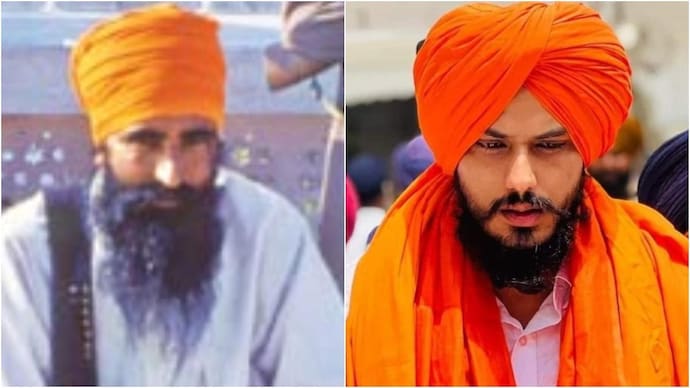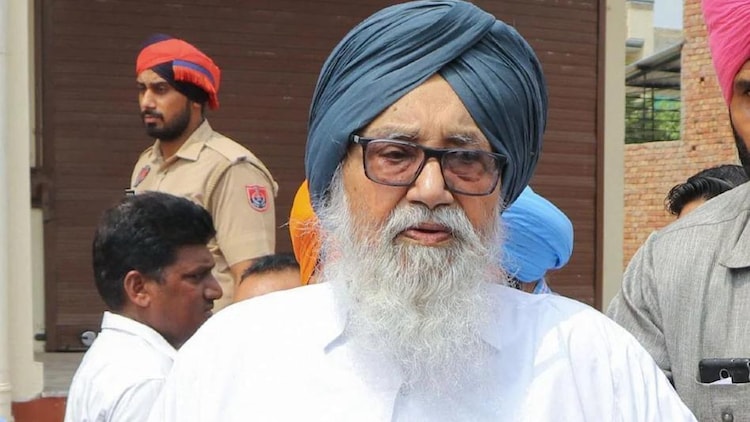
How Amritpal Singh is not Bhindranwala 2.0 | Analysis
Jarnail Singh Bhindranwale was a product of a political process, while Amritpal Singh's sudden emergence in the Sikh religious domain last year is more of a spectacle.

Apart from their robes, long beards, round turbans and armed guards, little ties Jarnail Singh Bhindranwale and Amritpal Singh together.
Bhindranwale was a product of a political process, while Amritpal Singh's sudden emergence in the Sikh religious domain last year is more of a spectacle.
BHINDRANWALA: A PREACHER MINTED IN SEMINARY
Born in 1947, Bhindranwale was raised as a “taksalia” Sikh. The word “taksal” literally means a mint. It refers to the Sikh seminaries which preach the unalloyed teachings of the faith.
In 1906, one of them, the Damdami Taksal, was moved to Bhinder village in Moga. Its incumbents came to be known as Bhindranwale.
Also Read | Operation Blue Star: How Congress invented a saint
A Brar Jat, Jarnail Singh, was the youngest son in a family of eight children. His father, Joginder Singh, was a religious-minded farmer.
He donated Jarnail Singh, then seven, to the Damdami Taksal.
Jarnail Singh learnt passages from Sri Guru Granth Sahib by rote and acquired knowledge about religion.
As he grew up, he toured villages, and soon became a dominant figure in the Damdami Taksal. He was elected as the head of the seminary after its leader died in a road accident in 1971.
Also Read | Bhindranwale 2.0: Who is Khalistani separatist leader Amrit Pal Singh?
“Joginder Singh,” write Mark Tully and Satish Jacob in Amritsar: Mrs Gandhi’s Last Battle, “described Jarnail Singh, when a young boy, as ‘someone who could fell a tree in a single blow and at the same time memorise whole chapters of the scriptures and recite them a hundred times a day.’”
His strongest supporters at the time, according to Khushwant Singh in A History of the Sikhs, were women and children who had suffered at the hands of their drunken or doped fathers, husbands and brothers.
AMRITPAL: NO ORTHODOX BACKGROUND
In contrast, Amritpal Singh was anything but an orthodox Sikh till he anointed himself as head of Waris Punjab De last year.
Uncut hair and beards are the hallmarks of practising Sikhs. The initiated among them wear all the five mandatory Ks - kes (untrimmed hair), kanga (small wooden comb), kada (steel bracelet), kirpan (small dagger) and kachchehra (traditional drawers).
Unlike Bhindranwala, who was stubbornly obsessed with the emblems of the Sikh faith since his childhood, Amritpal Singh had a fancy haircut before he appeared abruptly on the Sikh religious turf after spending years in Dubai.
Also Read | What kind of man is Sant Jarnail Singh Bhindranwale?
The Waris Punjab De pressure group he claims to be heading was originally founded by Punjabi actor Deep Sidhu.
And Sidhu was no different. He was another non-practising Sikh who shot into the national limelight after he filmed himself hailing the unfurling of the Nishan Sahib at the Red Fort on January 26, 2021 during the farm agitation.
The protesting farm unions distanced themselves from Sidhu as they saw in him a potential saboteur of their prolonged peaceful agitation aimed at the three contentious agricultural laws, which the central government eventually withdrew.
Sidhu died in a road crash in 2022. His family even disputed Amritpal Singh’s proclamation as his successor at Waris Punjab De.
Also Read | 31 years after Blue Star, Bhindranwale still hero for Jammu Sikhs
OLD VERSUS NEW-AGE “KHALISTANIS”
Like Sidhu, Amritpal Singh also projects himself as a proponent of “Sikh sovereignty”, a separate Sikh homeland called Khalistan.
The term Khalistan remained bluster for 30 years, since Punjab was divided by the Radcliffe Line in 1947.
On October 12, 1971, a London-based physician named Jagjit Singh Chohan, a former finance minister of Punjab, placed a Khalistan advertisement in The New York Times, proclaimed himself ''president'' of the dreamed-of independent Sikh state and produced passports, postage stamps and currency in its name.
But the Khalistani proponents before and after Bhindranwala never compromised their Khalsa looks. Almost all of them, militants and non-militant political activists, sported uncut hair and flowing beards.
Also Read | How Amritpal Singh is benefiting from a dominant narrative created by farmer unions
BHINDRANWALA: A PRODUCT OF POLITICAL PROCESS
Unlike Amritpal Singh, Bhindranwala was no surprise apparition in Punjab. He was a product of a political process.
In the wake of the disaster that befell Congress during the post-Emergency election, Sanjay Gandhi, the ambitious son of Indira Gandhi, wanted to break up the Shiromani Akali Dal, which had given his party severe headaches with its unrelenting mass protests from 1975 to 1977.
Sanjay Gandhi, on the advice of former Punjab chief minister Zail Singh, handpicked Bhindranwale to demolish the traditional Akali leadership.
It then consisted of the trinity of Parkash Singh Badal, Harchand Singh Longowal, who led the anti-Emergency protests, and Gurcharan Singh Tohra, one of the most experienced politicians and the head of the Shiromani Gurdwara Parbandhak Committee (SGPC) in Punjab.
Both Sanjay Gandhi and Giani Zail Singh, who later became the country’s home minister and then the president of India, note Tully and Jacob in their book, now needed a party to promote Bhindranwale in order to harass the Akalis.
Also Read | There are other key issues: Punjab minister Kuldeep Dhaliwal evades question on Khalistani leader Amritpal
That’s how the Dal Khalsa, which espoused Sikh sovereignty as its core agenda, came into being in April, 1978.
Bhindranwale and the Dal Khalsa were involved in the SGPC elections a year later. Four of his candidates won seats in the 140-member house then, often called the Sikh religious parliament.
Giani Zail Singh then had Bhindranwale campaign for Congress candidates in the 1980 general elections.
“â€æBhindranwale,” write Tully and Jacob in Amritsar: Mrs Gandhi’s Last Battle, “campaigned actively for the Congress in three constituencies. His name was already so influential that two of the candidates printed posters saying ‘Bhindranwale supports me’.”
Because of his hard line and violent defiance, Bhindranwala fell out with Congress, especially with the then chief minister Darbara Singh.
One of his lieutenants was arrested. He launched a morcha (agitation) to demand the man’s release.
Also Read | Amritpal Singh Sandhu: Punjab in panthic ferment
But the morcha wasn’t a great success.
The Akalis, on the other hand, were back to agitational politics.
Longowal launched a Dharam Yudh morcha on August 4, 1982 to seek implementation of the Anandpur Sahib Resolution, a document calling for greater autonomy for states within the Indian union.
The Akali leader co-opted Bhindranwala. Both agitations merged.
AMRITPAL: POLITICALLY UNTOUCHABLE
But no major political party has owned up Amritpal Singh.
Not just Congress, the BJP and AAP, even the present Akali chief, Sukhbir Singh Badal, was unforgiving when the young Khalistani ideologue and his men charged at the Ajnala police station in Punjab late last month, carrying Sri Guru Granth Sahib in a bus during their violent demonstration.
Also Read | What led to Amritpal Singh's meteoric rise to fame?
“This is shocking, unbelievable and unforgivable,” Badal said. “Never in Sikh history has anyone ever shown such brazen disrespect to Sri Guru Granth Sahib Ji as was done at Ajnala.”
THE KHALISTAN BLUSTER
Amritpal Singh talks about Khalistan. But so does the 77-year-old Sangrur MP, Simranjit Singh Mann. But then Mann is again nurtured in politics. Amritpal Singh isn’t.
Moreover, the insurgency that Bhindranwale and other militant groups of the 1980s led came against the backdrop of a cocktail of volatile issues - river waters, language, religion, geographical boundaries, the Emergency, the Akali-Congress rivalry, the rivalries within the Akali ranks and a Punjab-centric national politics.
But in a state where the democratic process takes place overwhelmingly now, from panchayat, assembly to Lok Sabha elections, the Khalistani narrative is actually nothing more than bluster once again.
More so when a non-political parachutist seeks to position himself at its fulcrum with his half-baked oratory and camera-friendly theatricals.
Also Read | Security agencies suspect Amritpal Singh gets funding from ISI




